Dental Email Marketing to Increase Patient Flow
Dental Email Marketing to Increase Patient Flow
Achieving a 450% patient increase in November and December for a multi-location dental practice was a win for our client, and made everyone involved feel proud.
To be fair, by no means are we the only ones responsible for this increase in patient flow. This is an established practice, with talented internal teams that support marketing campaigns where it matters most – directly with their patients.
This particular campaign was strong because of the processes put in place to support it.
It is a repeatable, achievable strategy that any dental practice can accomplish, even at a smaller scale.
It’s All About Their Benefits
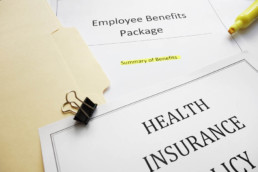
Wouldn’t it be great if all of your dental patients could actively plan out their check-ups and procedures throughout the year. They’d get the dental care they need, while at the same time, making the most of their own dental insurance plans.
Unfortunately, we’re all busy and sometimes our own dental care planning takes a back seat to soccer tournaments, vacation plans, and day-to-day life.
So how does a practice work to change this without coming across as self-serving?
It Started with a Survey

This annual campaign, called “Getting the Most out of your Dental Insurance” focused on patients’ awareness and understanding of their own benefits plan.
It began in July with an email marketing campaign to the entire patient list, promoting a short online survey created with the following focus points:
- We wanted to get patients asking themselves whether they take full advantage of their benefits – every calendar year.
- To generate awareness that unused benefits do not “roll over” into the next year.
- That paying insurance premiums and not using their benefits was the equivalent of paying their insurance provider for nothing.
- We also introduced the idea of larger treatments that could be split between years in order to maximize coverage.
Published Results

We gathered the data and produced a report to re-engage patients in a second email marketing campaign. We included comments gathered during the survey, as well as the top reasons people gave as excuses or reasons why they didn’t fully use their benefits.
- This allowed us to create some visual campaigns with memorable quotes.
- Stats that we could publish and promote online and offline.
- And a call-to-action that would be used throughout the remainder of the campaign.
Facebook Remarketing Campaign

We utilized content created throughout the campaign to gently remind patients about their “unused benefits” in a friendly and fun style – while they were on Facebook.
We retargeted using custom audiences: those patients who visited specific pages related to the awareness campaign.
An Increase in Planning for Larger Procedures

If we stopped here, this still would have been a successful campaign. But one of the key goals identified by the client, was to increase planning for larger procedures by the patient base that was most sensitive to pricing and payments.
They tagged client files on an ongoing basis that were potential candidates for more extensive dental treatments involving multiple visits.
This segmented email list was targeted with a 3rd email campaign, that noted the procedure discussed, and the options to split the treatment over the two calendar years.
Direct follow up by phone occurred within a week of the email campaign.
Misfirings
There can be a benefit to simply sending email reminders to clients about their expiring benefits. But this isn’t always true.
There are 3 elements that are important and help you make the most of this type of campaign:
1. Repetition
2. Timing
3. Tone – keeping this light and educational without being pushy or “salesy.”
As long as you implement the process appropriately and put in the work to get there, these kinds of results are achievable.
NOTE: Many extended health benefits include physiotherapy, chiropractors, massage therapy, acupuncture and much more. These are all healthcare practices that can utilize this same strategy.
Get more website traffic & leads with our proven approach to digital sales and marketing.
Get more website traffic & leads with our proven approach to digital sales and marketing.
Get more website traffic & leads with our proven approach to digital sales and marketing.
Get more website traffic & leads with our proven approach to digital sales and marketing.
5 Ways Reviews Help Your Business + 9 Ways to Respond to Reviews
5 Ways Reviews Help Your Business + 9 Ways to Respond to Reviews
We’re living in an increasingly digital world, and people are using computers and smartphones more often than ever before to shop for products and services and to evaluate their buying options.
As business owners, it’s an opportunity to expand our reach by creating an online presence – who wouldn’t like more customers? However, it’s also a responsibility, because we must be prepared for customer feedback from shoppers we’ve never met.
Whether or not we offer a feedback option on our websites, customers are reviewing our performance and commenting on our business online. It’s a given in today’s marketplace.
Consumers like to rave about products or establishments that serve them well, but they also have no compunction about complaining if their needs aren’t met. These customer reviews can work to our benefit; don’t underestimate their importance.
Respect Reviews
Reviews can be a boon to any business if they’re positive. Aside from recommendations from friends and family and advertising on company websites, online reviews are the third most trusted online advertising format.
According to Nielsen’s Global Trust in Advertising Survey:
Sixty-six per cent of respondents from 60 countries reported trusting consumer reviews online, compared to 70 per cent who are confident about owned online channels.
Reviews provide a number of benefits:
- Free advertising. When people rave about your product or service in a public, online forum, rejoice. It’s advertising that didn’t cost you any money and it can provide the mass exposure that you couldn’t afford through other channels, such as television or national publications.
- Improvement in search engine results. Some search engines, such as Google, consider the number of times your business name comes up in reviews and uses that information as part of their placement algorithm. You may appear higher in their search results.
- Peer influence. As noted above 66 per cent of respondents to the Nielsen worldwide survey trust online reviews, so they can affect a decision about a product or service.
- Customer connections. Reviews offer the opportunity to get to know your customers, people whose opinions you might never hear otherwise — they might have complained aloud to friends in the past. You also have the chance to respond to both positive and negative reviews, allowing you to offer explanations and to demonstrate that you care what customers think.
- Opportunity for improvement. Suggestions made by your customers may allow you to consider improvements to your procedures or service. Reviews are another source for business ideas.
Obtaining Reviews
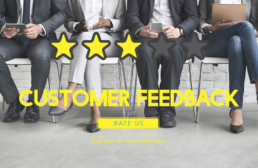
Now that you’ve learned more about the benefits of reviews, how can you go about getting them? The most important strategy? Ask for them.
- Familiarize yourself with platforms. Search for your business online to see which customers are using to post reviews of your work/product. Focus your attention on those your customers are using. Learn the rules that each of these key platforms applies to reviews so that you know whether incentives are allowed. Amazon, Yelp! And Google+ are common general platforms, while there are specialty platforms for certain industries, such as Trip Advisor for the travel industry.
- Tell customers directly. When you finish your job or sale, make it clear to your customers that online feedback is welcome. You can do this with a reminder included along with the invoice – it will depend on the type of business you run. However, be direct in asking for input. e.g., “If you like us, let people know by posting a comment on Google+.” You may wish to offer an incentive for reviewing performance, but it’s not required.
- Timing matters. Don’t wait months to ask for reviews, and be patient in acquiring them. Over time, a body of reviews will accumulate, but it may not happen instantly. Set up a system that prompts people to submit a review as soon as possible.
- Visual reminders. Find ways to remind customers about reviews: signs posted near the cash registers saying, “We’d love your feedback,” are an option; a selection of reviews on your website or in your newsletter is another idea. Be creative in your approach.
- Incentivize check-ins. Encourage people to check-in online at your location with an incentive. Once they do so, capture their co-ordinates and remind them to review their experience.
Responding to Reviews

We’ve already established that reviews are important, and research done by Professor Michael Luca at Harvard University shows how they can impact the bottom line: a one-star increase in Yelp! ratings led restaurants in his study to realize between five and nine per cent in increased profit. Keeping the ratings up is worth the effort.
However, not all reviews are good ones. Remember the old saying, “Take the bitter with the better”? It’s certainly true when it comes to online reviews. You may receive oceans of praise, but you’ll undoubtedly get criticism, too. As another old saying notes, “You can’t please all of the people all of the time.” Don’t expect perfection, although you can certainly strive for it.
If you receive negative reviews, it’s important not to ignore them. Think of all the people who visit your website. Do you want a negative impression to be the one that stays in their minds?
When preparing to respond to negative comments, do so graciously and sincerely. Remember that these people are passionate about your business or they wouldn’t have taken the time to write. Use this as an opportunity to show that they matter to you and to turn their negative feelings around.
-
- Take a deep breath. Don’t respond in anger. You may feel better if you vent your frustrations, but doing so online will only alienate your customers. They expect you to be above such petty behaviour. A moment of relief can lead to a loss of profits.
- Cordiality, not defensiveness. This is a public relations exercise designed to smooth the waters. It will be read by thousands of people over time. Demonstrate that you are professional and maintain a friendly tone.
- Don’t get personal. Even if your business is your baby, remember that the customer is expressing genuine feelings – we’re all entitled to them. It is likely to be an argument you won’t win, and it’s best to avoid burning bridges. If the reviews are inappropriate – using curses, etc. – take advantage of the platform’s reporting and removal protocol.
- Thank reviewers. Negative or positive, they’ve taken time to express their feelings. It’s input that you might not get otherwise and it might point to a problem you didn’t know existed. Thank them for their business and their feedback. If you have taken any steps to make a change or address the issue, explain those.
- Apologize for their disappointment. Focus your apologies on their negative feelings, since that is what prompted them to write in the first place.
- Reach out privately. In addition to your public response, you may want to contact the customer privately to explain what happened. Own up to a mistake if there was one and tell them about the steps you are taking to ensure it doesn’t happen again. Be honest and open.
- There may not be a good answer. Sometimes, you and the customer won’t see eye-to-eye. It’s okay to agree to disagree, as long as you do so politely.
Positive reviews are a pleasure to behold and responding to them isn’t as challenging, but a response is always nice to receive.
- Thank them. You value input and love to hear that people are pleased with your business, so tell them so succinctly. No long missives needed here!
- Don’t incentivize. As happy as you are about hearing good news, thanking a customer with incentives may seem like bribery. Instead, share some information about your business that they may not know.
After learning more about online reviews, here’s hoping you embrace them, even when they’re thorny. The more you work with them, the more comfortable you’ll be doing so.
Get more website traffic & leads with our proven approach to digital sales and marketing.
Get more website traffic & leads with our proven approach to digital sales and marketing.
Get more website traffic & leads with our proven approach to digital sales and marketing.
Get more website traffic & leads with our proven approach to digital sales and marketing.
Brand Personality - Don't Leave it to Chance
Brand Personality – Don’t Leave it to Chance
Is your brand personality desirable? Cool and confident, with a mix of the rebel thrown in? Or down-to-earth, reliable and trustworthy? If this feels like the start of a dating profile for your brand, you’re not far off the mark.
What is Brand Personality?
Whether you’re a start-up, or an established brand, having a well-defined personality is essential to creating a strong identity.
Brands that recognize the power of personality take the necessary steps and shape their brand personality with intention and purpose.
Personality is critical to success – for brands as well as people. Don’t leave it to chance!
Richard Branson
Define yourself or be defined by others. The fact of the matter is that people (consumers) give or “assign” personality traits to brands. So, how do they do this?
Generally, this assignment comes from the sum of their experiences with a particular brand.
In a nutshell, you can look at your own brand personality as the “ultimate personification” of your brand.
Apple Literally Personified Their Brand For Us and We Loved It
Don’t forget, there’s a natural fear of the unknown. It’s part of our DNA. It’s one of the reasons we reference the behavior of others.
This practice has kept us safe and allowed us to survive and prosper…not only on the school playground, but as consumers.
Customer testimonials soften the fear that most of us have. Remember, buying is an emotional decision at its core.
So does that mean you shouldn’t be self-promotional?
Not at all. Tell your prospects you’re great. Absolutely. Be proud of who you are and what you stand for.
Apple famously defined their brand personality in these series of memorable ads. The Mac guy is young, hip, and likeable. The PC guy is stuffy, rude, and generally unappealing.
Besides being clever and funny, these ads were effective because they accurately reflected the shared experiences of consumers at the time.
Who among us didn’t curse under our breath when the PC guy talked about our PC crashing or having to load program after program when we wanted to perform a simple task on our computer?
Clearly, brand personality is strongest when it resonates with consumers. When it’s real and authentic. When it matches the experiences they have actually had with your products.
It’s All About the Personality

As an individual person, you and I connect more easily with people who have specific personality traits. One of us may prefer the company of a “life of the party” type, while the other may prefer a more understated and emotionally reliable companion.
It’s no secret that we form deeper and more meaningful connections with certain types of people, and conversely, that we are unable to form connections with people who have personality traits that don’t match up well with us.
This is the same with brands. Consciously or unconsciously, brand personality shapes how people feel about and interact with your company.
As Aeker noted in her research:
If brands can be imagined by customers as human beings, by identifying themselves in a relationship with the brand, customers are more likely to prefer those with similar traits and characteristics.
So what are some brand personalities?
Aaker famously identified the brand personality dimensions of sincerity, excitement, competence, sophistication and ruggedness:
Sincerity
This factor refers to your brand’s level of authenticity. People are sceptical these days (some might even say cynical), and many of us want to do business with genuine, honest brands. The sincerity factor can be broken down into four facets: down-to-earth, honest, wholesome, and cheerful.
Think Kind.
Excitement
Does your brand get customers’ amped up? Sharing on social media with all their friends? If so, then your brand personality is likely covered under the excitement factor. This one refers to a sense of being spirited and carefree. Think of being daring, spirited, or imaginative. Young, trendy brands are often associated with this factor.
Think Red Bull.
Competence
Is your brand a leader or seen as an authority in your field? If so, then it likely falls under the competence factor. This one is characterized as intelligent, successful, and reliable. Think of brands that exhibit qualities like hard working, secure, technical, or confident.
Think Johnson & Johnson.
You now have to decide what “image” you want for your brand. Image means personality. Products, like people, have personalities, and they can make or break them in the market place.
David Ogilvy
Ruggedness
Do you want to convey a sense of unbreakable toughness? Then a ruggedness brand may be right for you. This factor is associated with being outdoorsy and tough. Its key traits include strength and resilience.
Think of Old Spice.
Sophistication
Does your brand portray a sense of aspirational luxury? Then it might give an air of sophistication. The sophistication factor is often associated with upper class style. Common traits include being glamorous, charming, and smooth.
Context Matters with Types of Brand Personality

Remember, a brand is a promise about a particular product…or your company, compared to another.
What your brand looks like, what it sounds like (your messaging) and how it acts in “real life” all impact how your customers or potential customers see and evaluate you.
And this is where context matters.
Let’s say you’re in a specialized medical field where trust, stability and a commitment to traditional research are vital components. It may be counterproductive to establish a brand personality like Virgin, that is often described as maverick and rebellious, combined with a sense of fun.
QUICK TIP
All sectors have tendencies. Certain sectors will naturally lean towards specific types of brand personality. When this becomes the assumed default…to the point of being stale and boring, there may be a unique opportunity to stand out above the noise. Think Airbnb in the short-term rental market.
Product extensions are one area where brands with strong brand personalities can find themselves in unfamiliar waters and is another example of the importance of context.
Harley Davidson is a world-class brand with a recognizable brand personality…but what were they thinking when they plunked that brand personality down in the middle of the perfume market? Harley Davidson perfume…uh, no.
Researchers have shown that brand personality can influence the perceived brand quality, the attitude to a brand, the trust in the brand, future buying intentions, and attachment and commitment to a brand. (Louis & Lombart, 2010)
Your Brand Personality in the Digital Age

We have evidence that brand personalities can affect the very existence and strength of the consumer relationship. It is a powerful tool that is underleveraged and poorly understood.
Jennifer Aaker, Professor of Marketing, Stanford
Nowadays, product characteristics like price, quality, distribution channels, packaging, etc. can easily be replicated by your competition.
The importance of differentiating a brand by using a strong brand identity and personality is more important than ever. When done well, it creates a strong competitive advantage.
It is much harder for competitors to copy a distinctive personality.
Consistency Matters

When there is inconsistency between your brand personality and the promise of your brand, consumers are confused and your brand suffers.
The basic building blocks of your brand personality include messaging, tone, imagery, design, and delivery.
- Message: when your actions consistently align with your message, your customers begin to trust you. When you’re inauthentic or can’t deliver, customers have every right to feel disappointed or deceived.
- Tone: it’s not what you say, but how you say it. It’s an expression of your company’s values and way of thinking.
- Design: using brand elements thoughtfully and strategically helps build visibility and increases customer recognition. In our highly visual world, visual identity plays a key role in the overall brand personality.
- Delivery: the delivery of your brand across channels significantly contributes to the consistency of your customer’s experience. The channels you choose (the telephone, in all the stores/locations, on the website and in face-to-face contact, etc.), as well as the frequency, all play a role in your brand personality.
Conclusion
The research is clear, brand personality matters to consumers and directly impacts sales, loyalty and direct product comparisons.
Yes, it takes purposeful planning and a consideration of all the elements that make up a brand personality.
But a distinct brand personality can make your brand stand apart from your competition.
Get more website traffic & leads with our proven approach to digital sales and marketing.
Get more website traffic & leads with our proven approach to digital sales and marketing.
Get more website traffic & leads with our proven approach to digital sales and marketing.
Get more website traffic & leads with our proven approach to digital sales and marketing.
Testimonials that Deliver Customers
Are too many of your potential customers scared to buy from you? Are you frustrated that you’re getting decent traffic to your website but your visitors seem reluctant to purchase from you or even contact you?
It may be time to have a look at your testimonials.
It’s no secret that the opinions of others matters to us. Psychologists and marketers know and utilize this principle of “social proof.”
And that’s why the right testimonials need to be a part of your marketing.
They are powerful.
90% Of Customers Say Buying Decisions Are Influenced By Online Reviews
Marketing Land
When a prospective client reads, watches, or listens to your testimonials, it’s like somebody’s whispering over their shoulder, “trust me…I felt like you…it’s gonna’ be all right.”
Their fear is fair. They don’t know you. Not yet.
And yes, you may be incredible. You may deliver the most fantastic product or service.
In fact, you may be EXACTLY what your future customer is looking for.
But they need some help to get there. And testimonials, done right, can move that needle in the right direction.
It’s especially important in the online world – where your customer may not be able to walk into your store or visit one of your locations because you’re half way around the world.
The research is pretty clear:
Customer testimonials have the highest effectiveness rating for all types of content marketing, with a rating of 89%.
Don’t forget, there’s a natural fear of the unknown. It’s part of our DNA. It’s one of the reasons we reference the behavior of others.
This practice has kept us safe and allowed us to survive and prosper…not only on the school playground, but as consumers.
Customer testimonials soften the fear that most of us have. Remember, buying is an emotional decision at its core.
So does that mean you shouldn’t be self-promotional?
Not at all. Tell your prospects you’re great. Absolutely. Be proud of who you are and what you stand for.
But make no mistake about it, another person’s positive perception of you holds more credibility than any other marketing message because:
- There is trust.
- There is an implied impartiality in a third party opinion.
They love you…other’s love you. Yup, you are the real deal!
Testimonial examples – why one size does not fit all
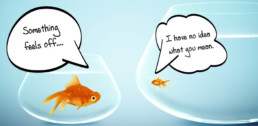
The prevailing and often contradictory wisdom surrounding client testimonials, is that there are hard and fast rules you MUST follow in order to successfully utilize this social currency, like:
– client testimonials need to be as specific as possible
– client testimonials should use relevant numbers
– a customer testimonial that is short and simple is best
– customer testimonials with longer stories convert better
In our experience, you need to test which kinds of customer testimonials work best for you in specific ways.
In some cases, a couple of effective sentences will perform well.
Sometimes, a story works best.
Over time, as you gather more and more testimonials, you need to test which kinds and combinations work best for you in your market.
Faces add elements of trust to testimonial examples

Real faces, real names, and company names add authenticity.
Without these trust signals, the customer testimonial is weaker.
While some industries necessitate privacy for obvious reasons, the optimal choice is to go with authentic details and a picture.
A picture will enhance the persuasiveness of honest reviews.
Video testimonials can pack a punch
Seeing a customer on-screen makes his or her statement even more credible.
If securing this type of customer testimonial is possible for you, then make it a priority. It will pay dividends. And don’t worry too much about production levels for this type of video (but do make sure the sound is decent).
Customer video testimonials feel real because they are. If a picture is worth a thousand words, then, according to Dr. James McQuivey of Forrester Research, a minute of video is worth 1.8 million words.
When a visitor lands on one of our landing pages with a video testimonial like the one above, they are 188% more likely to convert into a lead.
There are so many elements about client video testimonials that work in your favour that I could dedicate an entire post to that. But briefly, here are a few points to chew on:
- Video is the most shared brand content on Facebook (Zuum)
- A study by Comscore found that, on average, a website visitor will stay two minutes longer on a site when they watch a video.
- When we see “real” people talking…it adds a personal and human level to what can sometimes be a very impersonal online world.
QUICK TIP
A great time for an improvised video testimonial is when you’re meeting with clients or reviewing how a project went. That’s how we collected this very under-produced video testimonial you see above.
Webcam testimonials can add an element of authenticity
Sometimes, circumstance (distance, convenience, time) restrict our ability to capture a video testimonial in an ideal face-to-face environment.
Don’t worry. Nobody is expecting Steven Speilberg. Do the best you can within your given situation.
Almost everyone has a webcam or a smartphone with video options. This can add to the “realness” of the video. It can even add a little charm.
This webcam testimonial here, hit on a lot of the necessary elements of a great testimonial:
- industry context, within the use of the client’s product
- a recognized leader within the target community
- the under-produced nature of the video lends to the “realness” of the story

Encourage reviews & consider Google trusted 3rd party reviews
If you have an ecommerce site, you need to make it as easy as possible to leave a review. And make sure you place them where they can’t be missed.
This website here uses an approved third party service for collecting reviews and syndicating them to sites like Google.
Why pay to use a 3rd party independent reviewer?
We’ve all heard stories about fake reviews. The fact that these reviews are verified may create more confidence in your website visitor.
And “approved by Google” means your reviews can show up in product searches like the one shown below. This can be a critical step in performing well if you have a Google merchant account for your ecommerce site.
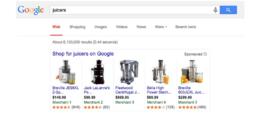
Customer testimonials need to be part of your processes
If you don’t have a process for collecting customer testimonials you’re hurting your current and future business.
If you know and believe what you do is good, then the world needs to know that. And hopefully, we’ve already established that hearing it from your customers and clients is the best way.
Feel like you’re begging when asking for client testimonials? Don’t! Here’s how:

Ask for feedback, and don’t use the word “testimonial” if it has baggage for you. Keep in mind, feedback can be structured. And that takes the pressure off you and your customers.
Asking customers the specific question, “can you give me a testimonial?” can often trigger the deer in the headlights look.
Not because they don’t value you or your service. But because you’re not giving them any real context and direction. You’re asking them to be creative. They may not be.
Feedback takes you out of that loop and provides you with a structured way to get:
- Honest comments about your company and what you do.
- More context about how your product or service fits into the big picture for your client.
- Details from this evaluation that could positively relate to other similar prospects.
A testimonials page, or throughout your site?
It used to be common practice to have a single dedicated client testimonials page at your website.
While this is still important in some niches, testing can show us that having testimonials at key locations of your website can have more of an overall impact.
Client testimonial placement can drastically affect your conversions. Heatmap tracking at this client site showed us that testimonials were not getting enough action where they were on the page, so we moved them to a different place and got the results we needed.

You know how important social proof is, so don’t make your customers hunt for a testimonial.
Great places to test customer testimonial placement include:
- On your homepage above the fold.
- Near your sign up form.
- In your sidebar.
- On your product page.
- On your landing pages.
When to ask for customer testimonials?
Sometimes clients feel that their customer testimonials should just happen naturally and organically. And while that does happen on occasion, it’s not a realistic approach for such a vital part of your marketing.
Ideally, for reviews, you want to ask customers when they’re happiest about what you’ve offered them, which is usually when the experience is fresh.
This online home insurance provider here asks for testimonials right after their product is purchased. That’s enabled them to incorporate a staggering number of positive reviews in a traditionally conservative industry that struggles in this area.
Some products or services require more time to deliver outcomes, so in those situations, you’ll want to be mindful of those timelines.
Conclusion
Customer testimonials and reviews can be a difference-maker in your business, as long as you use them the right way.
Take the time to create a process that allows you to gather and make the most of them.
Get more website traffic & leads with our proven approach to digital sales and marketing.
Get more website traffic & leads with our proven approach to digital sales and marketing.
Get more website traffic & leads with our proven approach to digital sales and marketing.
Get more website traffic & leads with our proven approach to digital sales and marketing.
October 9, 2015
Is Your Website Design Hurting You?
Is Your Website Design Hurting You?
Is your website underperforming? Or worse, making you look like an amateur?
It could very well be your website design.
Fair or not, your prospects judge you by your website design.
The research is clear – potential customers are visiting your website and judging your business based on what they see.
75% of people judge the credibility of a company based on the design of its website
Stanford University
If your visitors like what they see, then they stay. Consume your content.
Engage and interact with your site.
And if you’ve planned out an effective sales funnel, they then become your new customers.
If they don’t like what they see – they quickly CLICK AWAY.
Gone forever. Off to your competition.
Ouch!
Of course, snap judgments aren’t breaking news. You and I do it everyday.
The fact is, we’re genetically hardwired to make split-second decisions.
So how much time does your website have… so potential customers dig deeper?
50 milliseconds (source).
Gulp.
Your website only has 0.05 seconds to make a good first impression.
Blame evolution for our ability to make judgements in the blink of an eye.
Great for when a big scary animal could eat us.
A different challenge when you’re trying to get potential customers to give you a shot at their business.
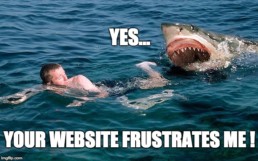
So how can you make the most of these 0.05 seconds? No pressure, right?
A good start, is by knowing how the brain creates shortcuts based on expectations.
Science calls these expectations “prototypical elements.”
In the case of your website, there are a number of prototypical elements your website visitors expect to see. Here are only a few:
- clear and intuitive navigation (the #1 design complaint about websites is difficult navigation)
- site copy that is easy-to-read and adds clarity to their overall experience
- a check-out in the top right corner (if you’re an ecommerce site)
- trust-building elements, like customer testimonials or reviews
When your website doesn’t conform to their expectations, it’s harder for your customer.
And harder is typically bad for sales.
When the worst happens, your potential customers will judge your website as either too confusing or poorly designed.
And leave.
Again, in the blink of an eye.
Beautiful design wins - and you get more customers

Like me, you probably noticed the red hat immediately. Your eyes might have been drawn to the arms, as they provide a kind of a frame for the hat…and if you took a deeper look, you may have followed the direction the woman is looking, with your eyes moving up her legs to her feet.
Then, to the contrast of the blue water, slightly lapping against the woman’s legs. Then, to the darker blue in the shape of a person’s shadow (presumably a man) looking toward the woman.
Clarity of focus and simplicity are prized design elements. And for good reason. Effective visual design can create a story worthy of your brand.
A compelling emotional connection.
A connection that the research supports. According to this Google study, website visitors consistently rated visually simple websites as more beautiful.
And the opposite is true – when the visual complexity of your website is high, your potential customers perceive it as less beautiful.
SIMPLE = BEAUTIFUL.
Even with layouts that had a high level of familiarity, simplicity and beauty won the day.
And beauty converts better.
As Steve Jobs famously said:
Simple can be harder than complex: You have to work hard to get your thinking clean to make it simple. But it’s worth it in the end because once you get there, you can move mountains.
Today more than ever, companies rely on their website to communicate who they are to their potential customers.
To develop that important emotional connection.
Don’t forget, your website is often the first face your customers will see. The first point of contact.
If that’s not to your benefit, it’s critical you change that.
The good news, is that research-based and field-tested web design practices allow you to make a strong first impression. And those same practices allow you to shape the customer journey.
To lead your potential customer down the path to increased conversions.
And that means more paying customers.
It’s part art, and a whole lot of science.
The science and psychology of effective web design

The research and science of website design has become more and more sophisticated. And it’s impact on consumer purchasing behavior can now be measured.
And that makes it a valuable tool in your marketing.
So, in a world where today’s consumer has almost limitless options…all within the click of a mouse, where’s a good place to start?
Not surprisingly, attention is one of “the” critical elements to success.
When visitors come to your website, grab and keep their attention.
The emotional brain (which has a huge impact on our decisions) is affected by pictures. So use them to your advantage.
Especially pictures of people.
Used correctly, they are one of many tools that can help your visitors focus. And focus reduces friction.
That helps buyers buy from you.
As Victoria Young puts it:
Today, the most successful digital experiences have emerged out of focusing on reducing friction in the user journey.
And what exactly is friction at your website?
Anything that makes life too difficult for your visitor.
In user experience, friction is defined as “interactions that inhibit people from intuitively and painlessly achieving their goals.”
Friction is normally bad because it reduces conversions, and frustrates potential customers to the point of abandoning their tasks.
In other words, don’t make your website visitor work too hard.
Visitors will do the least amount of work possible to get a task done – like buy your product.
An example of page scanning patterns
Well known eye-tracking studies like this and this show us how users view website content and how visual relationships affect their focus on the page.
With attention at a premium, it’s critical that every element on a page adds value to your visitor.
Of course, a large number of elements influence the visual design of your site. Here are only a few:
- font selection
- white space
- contrast
- size
- color
When we utilize any of these elements in purposeful ways, we need to consider how they impact our visitor.
And we need to remember that web surfers skim.
We hunt and peck.
Seeking out information that’s relevant.
And most of the time…disregarding information that isn’t.
When we work within this framework, we can create page design patterns that work for your customers.
And ultimately, help your business grow.
Designing your website for your users requires testing

Making informed choices and improving visual design—including layout, color, graphics, and text choice – is a process.
When done well, your website becomes your top salesperson.
Generating leads.
And revenue.
24 hours a day, seven days a week.
It’s begins with a clear understanding of design principles and human psychology, in the context of clearly defined business goals.
It is refined through testing.
And more testing.
And still more testing.As user experience expert Jeff Horvath says here:
A good user experience, like a measurable ROI, doesn’t typically happen by accident. It takes careful planning, analysis, investment, and continuous improvement.
Conclusion
Bad design can be frustrating and inconvenient. And it can hurt your business.
Because your visitors determine the success of your website, they should be the focus of your research and design.
Naturally, understanding the principles of design is critical. And knowing what rules can be broken and how they can be applied effectively takes context that comes with experience.
But make no mistake, testing is a key part of the web design process.
Effective design – and one that improves your bottom line – is about researching what makes your buyers buy from you. And then delivering that message in a visually beautiful and engaging way.





